Soft and tender egg free yellow paleo cake made with coconut flour. Only 15 minute prep and about 25 minutes to bake with only 8 ingredients! This cake is dairy, nut, and egg free! Top it off with a paleo chocolate frosting, coconut whipped cream, or enjoy it as is!
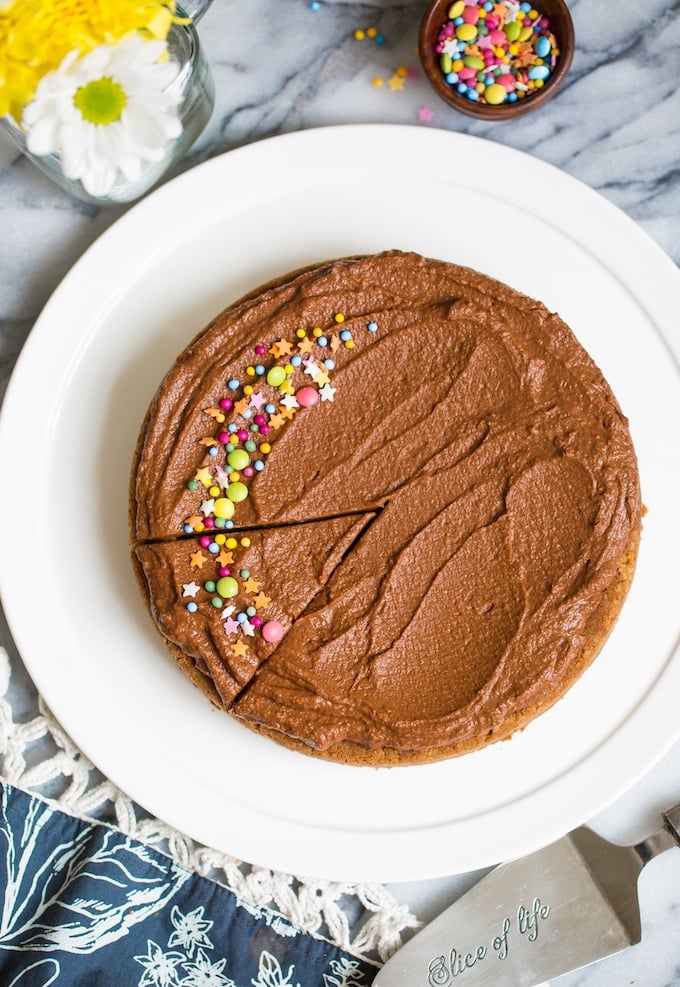
I can’t even tell you how much of an accomplishment it feels like to FINALLY have nailed this egg free + nut free vegan coconut flour cake recipe. No joke.
I’m not even exaggerating when I say that I went through at least 10 different variations of this coconut flour cake before finally getting it right. About halfway through all my testing I had to take a couple weeks off because I was so burnt out on baking cakes.
It’s my holy grail of recipe developing and I am so PUMPED to finally be able to share it with you guys! So let’s get to it…
Baking with Coconut Flour
So here’s the thing about coconut flour: it’s notoriously difficult to work with. I go into more detail about the ins & outs of baking with coconut flour in another post, but the gist of it is that’s just an extremely absorbent flour. You really need a lot of moisture in your ingredients which is why eggs are almost always a key ingredients in many coconut flour baked goods and why it took me so long to deliver on an egg free version of the original cake.
How to Make: Egg Free Paleo Cake with Coconut Flour
The base for this recipe comes from my paleo coconut flour cake that I shared a while back. The core ingredients are the same though the amounts themselves do differ by quite a bit: coconut flour, tapioca flour, coconut oil, vanilla etc with the addition of coconut milk for added moisture to replace the eggs.
Making the cake itself is pretty easy. The prep time should really only take about 15-20 minutes. It’s mostly just a matter of whisking and combining.
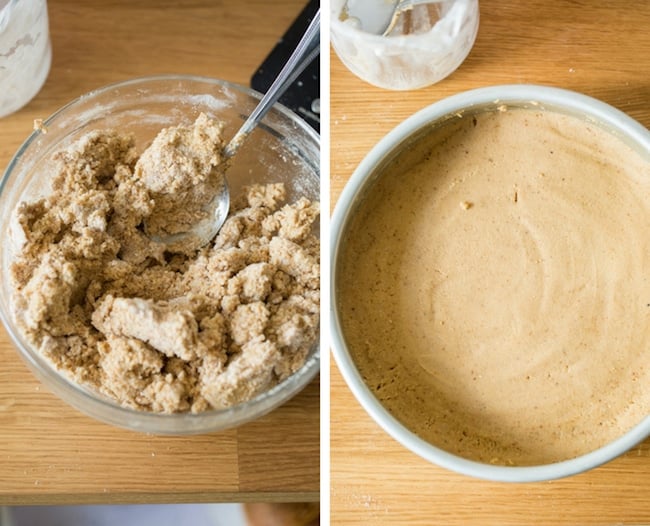
A Note about the Batter/Dough
That all being said this cake making process will look and feel very different to what you would normally be used to when it comes to baking cakes. Instead of making a batter, this makes more of a dough. It’s thick and pliable and really needs to be handled differently than typical cakes.
Start out by mixing the wet and dry ingredients together separately: mix the flours and sugar in one bowl and the oil, milk and vanilla in another. To combine, pour the wet into the dry and mix together with a spoon as much as you can. Once your dough/batter resembles the clumpy dough in the picture above start using your hands to finish mixing. Clump the dough together and scrape down the sides mixing it all together.
When you’re ready to bake, transfer the dough into your greased cake tin. Since the dough is so thick you’ll need to smooth it out into the pan yourself. It should look and feel very soft at this point like in the second picture just above.
Then just pop it in the oven for about 25ish minutes and that’s it!
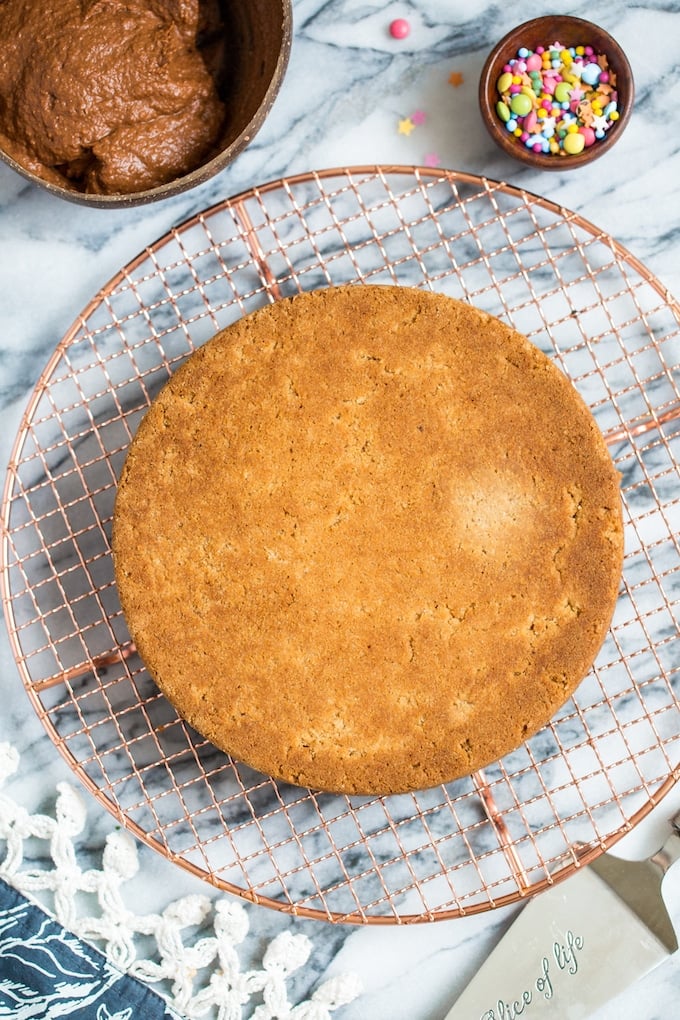
Tips for success
- The coconut oil should be melted in a liquid state and cooled to room temperature so that it mixes into the dough easily.
- The coconut milk should also be room temperature.
- Ideally you want to use a full fat coconut milk for the extra moisture. If your coconut milk is one that separates the cream from the water just stir it up or shake the can well before using.
- Don’t be afraid to use your hands to mix the batter/dough together. I personally find it easier than a mixing spoon in this recipe.
The end result
Since baking soda + apple cider vinegar are the only leavening agents here, keep in mind that this isn’t going to rise up very much. That being said this paleo cake is very soft and tender.
If you’re in the need of a good birthday cake you can easily double the recipe to make a couple of layers! This recipe is the perfect treat to make for someone with a lot of food allergies as it’s:
✔️Gluten Free
✔️Dairy Free
✔️Egg Free
✔️Nut Free
✔️Vegan
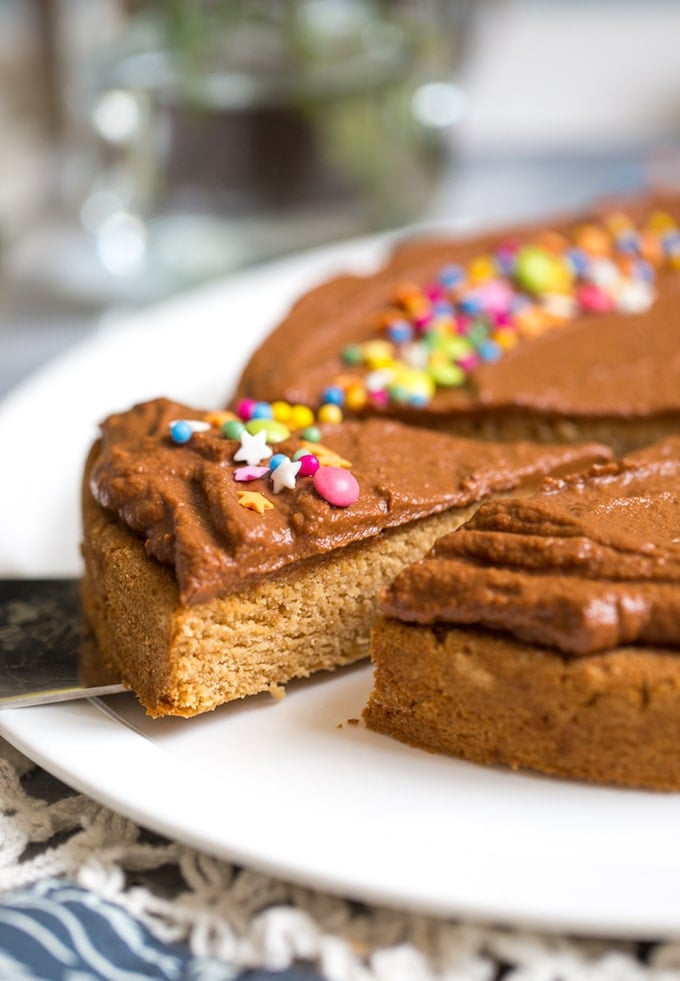
I hope you enjoy this cake as much as we do – if you try it out please let me know what you think!
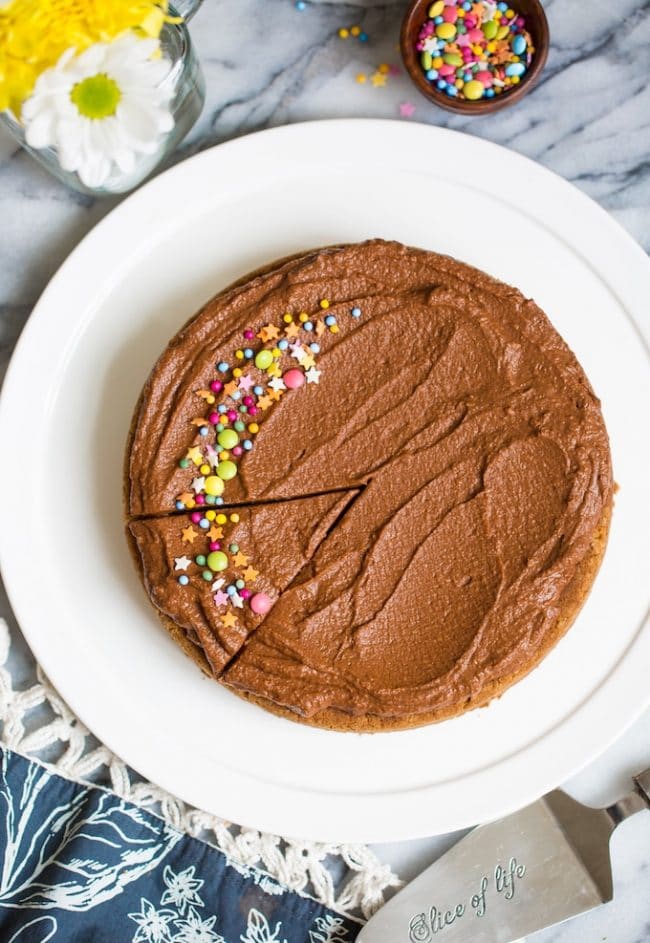
Egg Free Coconut Flour Paleo Cake
Soft and tender, egg free yellow paleo cake made with coconut flour. Only 15 minute prep and about 25 minutes to bake with only 8 ingredients! This cake is dairy, nut, and egg free! Top it off with a paleo chocolate frosting, coconut whipped cream, or enjoy it as is!
Ingredients
- 1 1/4 cup (300g) full fat coconut milk, stirred from a can
- 1/4 cup (60 ml) coconut oil, melted and cooled
- 1 teaspoon vanilla extract
- 1 teaspoon apple cider vinegar
- 1 cup (112g) coconut flour, lightly packed
- 1/4 cup (28g) tapioca flour
- 3/4 cup (135 g) coconut sugar
- 1 teaspoon baking soda
Instructions
- Preheat oven to 350°C/180°C. Lightly grease an 8inch round cake tin and set aside.
- In a small bowl or mixing cup whisk together the coconut milk, coconut oil, vanilla extract and vinegar until combined. Set aside.
- In a medium sized mixing bowl whisk together the coconut flour, tapioca flour, coconut sugar and baking soda until no lumps remain.
- Pour the wet mixture into the dry and stir to combine. The cake batter will be very thick and look more like dough than typical batter. This is easiest to mix using your hands. Once fully combined transfer the batter/dough to your prepared cake tin. Smooth out the dough to the sides and across the bottom in an even layer.
- Bake for 25-28 minutes. The top will be golden. To check for doneness insert a knife or toothpick into the centre of the cake - if it comes out clean and without any crumbs then it's done.
- Transfer the cake onto a wire cooling rack and let cool. Make sure it's completely cooled before frosting.
Notes
Tips
- Coconut milk & coconut oil should be the same temperature so that they mix together easily.
- Ideally you want to use a full fat coconut milk for the extra moisture. If your coconut milk is one that separates the cream from the water just stir it up or shake the can well before using.
- Don't be afraid to use your hands to mix the batter/dough together. I personally find it easier than a mixing spoon in this recipe.
Frosting Ideas
- I used my paleo + vegan sweet potato frosting in these pictures (nut free).
- Coconut whipped cream
- Enjoy as is!
Leftovers
Unfrosted leftovers can be kept at room temperature in an airtight container. This is best eaten within 2-3 days. If frosted, store in the fridge.
Final Note:
I have not tried this cake using any variation of flours/sweeteners so I'm afraid I don't know how to advise on substitutions.

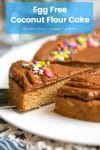
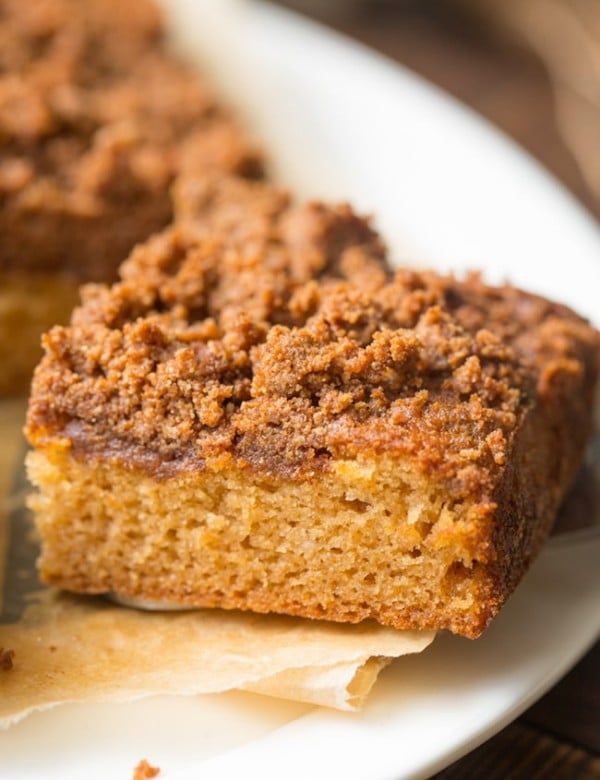
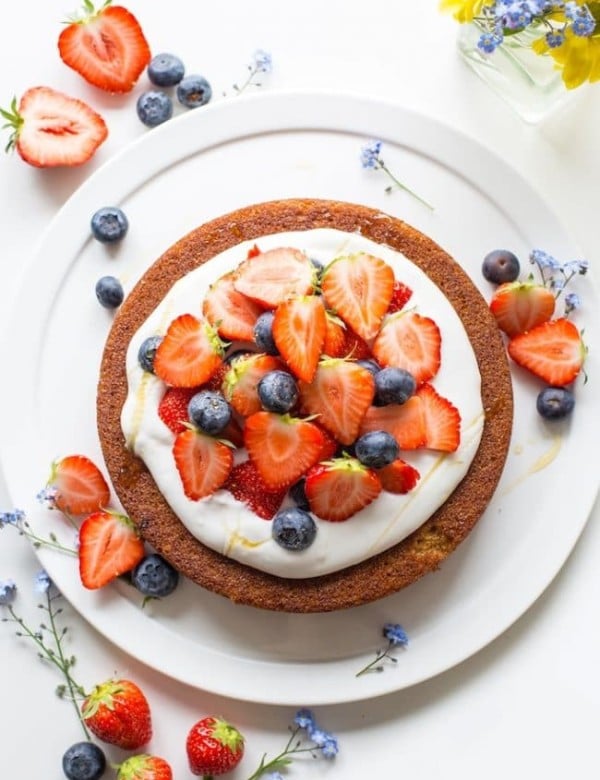
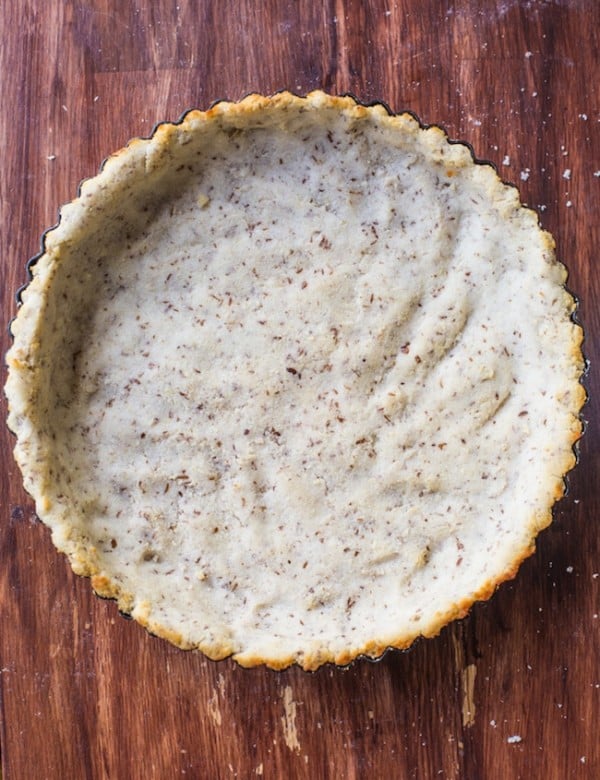
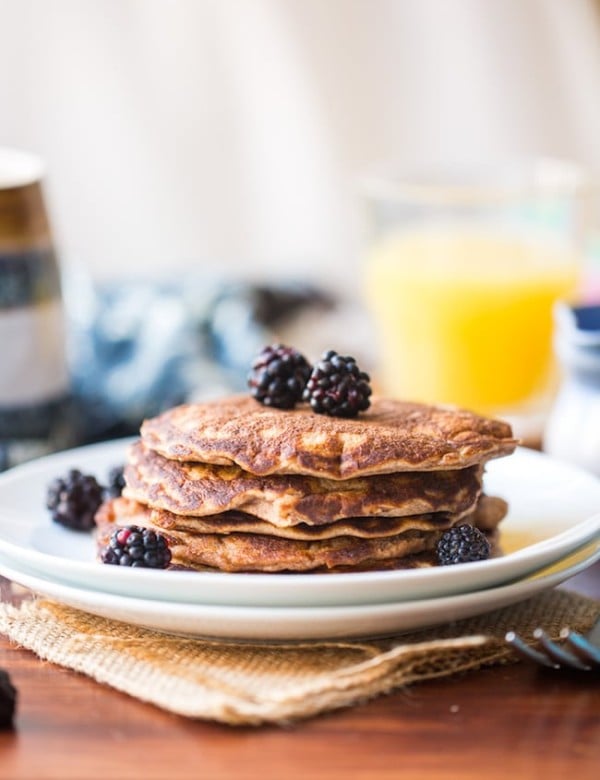


Victoria says
Dear Sarah,
thank you so much for this recipe, the cake is wonderful !
If I wish to make it less sweet and diminish the amount of sugar, how I should replace it ? By adding the equal amount of tapioca and coconut flour ?
Or should I take a different non-gluten flour ?
Many thanks !
Sarah Nevins says
Hi Victoria!
Sorry I didn’t get back to you sooner – I’ve been thinking about your question. I did a lot of testing before I first shared this recipe and I just don’t want to give you the wrong advice. Before I got this recipe right there was a lot of trial and error (and a lot of bad cakes) that went in to it. The problem is that coconut flour in particular can be a very tricky ingredient when it comes to tweaking and substituting. It’s not a flour that can be easily swapped with another without also increasing or decreasing other ingredients. If you increase the amount of coconut flour without also increasing the amount of liquid or fat ingredients your cake might get too dry. If you increase the amount of tapioca flour by too much you then run the risk of the cake becoming too gummy/chewy.
If I were playing around with getting rid of the sugar I would probably increase the tapioca by only 1/4 cup (so you would need 1/2 cup tapioca flour in total) and omit the sugar all together. I think those changes would still make for a cake with the most similar texture. That being said, I haven’t tested this cake this way so I can’t say for sure.
If you are trying to make a savoury cake I might also recommend adding dried herbs and spices and maybe even some nutritional yeast for some flavour. By getting rid of the sweetness from the coconut sugar your cake might end up tasting a bit bland. Worst case scenario you end up tasting the metallically flavour of baking soda too much.
Sorry I can’t be too much help here! With your question in mind though I think I might need to do some more testing for a savoury cake/bread version of this recipe!
Hagar says
Hi Sarah,
Can i use cassava flour instead of tapioca flour?
If you think it would still work, would I use the same amount as tapioca flour?
Sarah Nevins says
Hi Hagar! I’m afraid I don’t know how cassava flour would work as a replacement here. I wish I could be more help, but I wouldn’t want to steer you wrong without trying it out myself.
Jse says
Any suggestions on how to adjust baking time to bake this in a loaf tin? Also a suggestion that you have a jump to recipe link at the top. Thanks.
Sarah Nevins says
I’m not positive, but you’ll likely need to increase the cooking time by at least 15 minutes. I recommend your cake at about 30 minutes just to be on the safe side and then assessing from there. Sorry I can’t be too much help here. I just don’t want to steer you wrong!
Jasmine Stevenson says
HI
My coconut milk and oil etc has just separated and is all clumpy. How can I save this?
Sarah Nevins says
Hi Jasmine! I’m guessing this might have happened if the coconut oil warmed up the coconut milk too drastically. Coconut milk cuddling is usually related to temperature. Sometimes you can fix this by blending it in a blender on high. Was it still separated even after you mixed it in with the dry ingredients?
Kiki says
This is my new favorite recipe! I have made it twice, and it is so good! Thank you for sharing!
Sarah Nevins says
Yay! Thanks so much Kiki – that makes me so happy to hear! Thank you also for taking the time to come back to leave a review!
Karina says
Hi, can I sub the tapioca flour with xantham gum? It would be 1 TSP?
Sarah Nevins says
Hi Karina! It’s hard to say how this cake would be with such a huge swap. By omitting 1/4 cup flour for 1 teaspoon gum you would end up changing the balance of wet to dry ingredients and I’m just not sure how that would end up after baking. I also just want to note that the tapioca isn’t just for binding here – it’s important for the overall texture of the cake.
Hope that helps!
Geetika Khanna says
Hi..can we use brown sugar instead of coconut sugar, and if we add both baking powder and baking soda, wil the cake rise even better??
Also if u could provide substitute for tapioca flour?..
Sarah Nevins says
Hi there! You can use brown sugar in place of coconut sugar. As for the baking powder/baking soda – baking powder will give this cake more of a lift, but it’s not going to make a huge difference for a cake like this.
Pooja says
Hello Sarah, I wanted to know if I can use a substitute for Coconut Sugar? Like Stevia/Monk Fruit.
Thanks,
Sarah Nevins says
Hi there! I’m afraid I’m not too sure how other sugar substitutes would work without trying it out myself first. This cake was really tricky to nail down and I worry that deviating too much from the main recipe might not work. Unfortunately monk sugar isn’t something that I can buy where I live so I’m not totally sure but I think that might work (in sugar crystal form) if it’s a 1:1 swap.
I have also had quite a few readers try making this with different types of sweeteners (maple syrup, splenda, honey, blended up dates) but I’m not sure if those are safe for a candida diet like you mentioned in the other comment.
Pooja says
Hello. I am looking to try this recipe over the weekend. I am on the Candida diet and therefore cannot have sugar. What is the best substitute for the coconut sugar? Thank you.
Janani says
Hi Sarah,
Tried this today and it came out beautifully. I don’t own a round baking tray so used a square one instead & kept it for 5 mins longer. The cake was evenly cooked. It was a tad bit too sweet for me, so next time i’m going to try this recipe with 2/3 cup of coconut sugar. But overall, this recipe is a keeper 🙂
Sarah Nevins says
So glad to hear you enjoyed it! Good to know about the square baking tin as well!